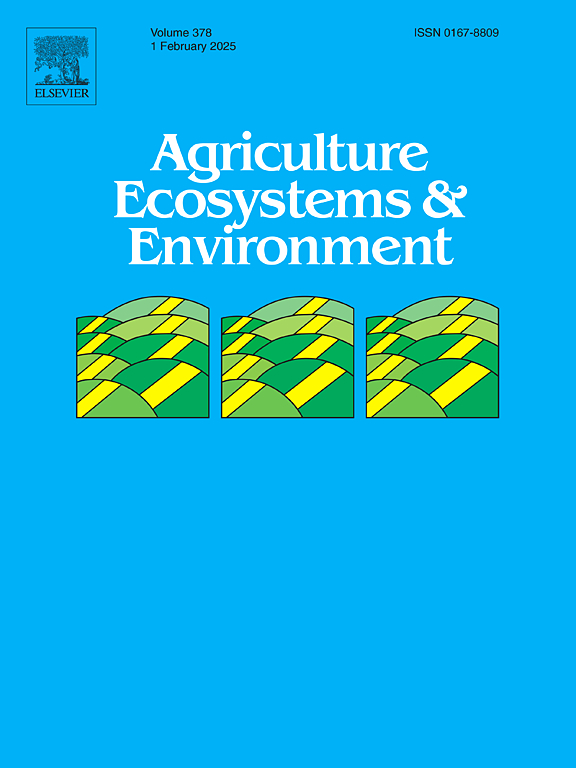Conversion of arable land to perennial bioenergy crops increases soil organic carbon stocks on the long term
IF 6
1区 农林科学
Q1 AGRICULTURE, MULTIDISCIPLINARY
引用次数: 0
Abstract
Perennial C4 bioenergy crops can combine high productivity and low input requirements. However, their impact on soil organic carbon (SOC) stocks remains uncertain. The aim of this study was to assess the long-term impact of converting arable land to perennial bioenergy crops on SOC stocks for two crop species (miscanthus and switchgrass) and several crop management practices (nitrogen fertilization, harvest date and irrigation). We analyzed two long-term experiments located in northern and southern France. Both sites were sampled initially and after 12 or 13 years. SOC stocks were calculated at equivalent soil mass in each site and δ13C measurements were used to calculate changes in “new” and “old” SOC stocks. SOC stocks in the old ploughed layer increased significantly in both sites but most of the SOC storage occurred in the topsoil layer (∼0–5 cm). SOC storage rate was fairly similar between miscanthus and switchgrass but was much greater in the southern site than in the northern site (0.96 vs 0.26 t C ha−1 yr−1). This larger storage rate was mainly explained by higher carbon inputs, as suggested by the higher accumulation rate of new SOC (1.41 vs 0.86 t C ha−1 yr−1). No significant effect of the management practices on the SOC change rate could be detected, but early harvest systematically reduced SOC storage compared to late harvest (by 33 % for miscanthus and 12 % for switchgrass). Higher carbon inputs due to late harvest or irrigated conditions were partly compensated by a higher old SOC decrease.
从长期来看,将耕地转化为多年生生物能源作物增加了土壤有机碳储量
多年生C4生物能源作物具有高产和低投入的特点。然而,它们对土壤有机碳(SOC)储量的影响仍不确定。本研究旨在评估多年生生物能源作物对两种作物(芒草和柳枝稷)和几种作物管理措施(氮肥、收获日期和灌溉)有机碳储量的长期影响。我们分析了位于法国北部和南部的两个长期实验。这两个地点最初和12或13年后都进行了采样。利用δ13C测量值计算各样地等效土壤中有机碳储量的变化,并计算“新”和“旧”有机碳储量的变化。两样地老耕层有机碳储量均显著增加,但大部分有机碳储量集中在表层(~ 0 ~ 5 cm)。芒草和柳枝稷的土壤有机碳储存率基本相似,但南区的土壤有机碳储存率远高于北区(0.96 vs 0.26 t C ha−1 yr−1)。新的有机碳积累速率较高(1.41 vs 0.86 t C ha−1 yr−1),这主要是由于碳输入较高所致。管理措施对土壤有机碳变化速率没有显著影响,但与收获后期相比,早期收获系统性地减少了土壤有机碳储量(芒草减少33% %,柳枝稷减少12% %)。由于收获晚或灌溉条件导致的高碳输入部分被较高的旧SOC减少所补偿。
本文章由计算机程序翻译,如有差异,请以英文原文为准。
求助全文
约1分钟内获得全文
求助全文
来源期刊

Agriculture, Ecosystems & Environment
环境科学-环境科学
CiteScore
11.70
自引率
9.10%
发文量
392
审稿时长
26 days
期刊介绍:
Agriculture, Ecosystems and Environment publishes scientific articles dealing with the interface between agroecosystems and the natural environment, specifically how agriculture influences the environment and how changes in that environment impact agroecosystems. Preference is given to papers from experimental and observational research at the field, system or landscape level, from studies that enhance our understanding of processes using data-based biophysical modelling, and papers that bridge scientific disciplines and integrate knowledge. All papers should be placed in an international or wide comparative context.
 求助内容:
求助内容: 应助结果提醒方式:
应助结果提醒方式:


